If you are ready to enhance your web design with expert solutions, let’s talk!
Customers land on your platform, and it feels like it was designed just for them. The products they need, the recommendations they get, and the seamless navigation. Everything feels so close, so effortless, so ‘wow.’ Sounds awesome? Yeah, that’s the magic of AI-powered personalization in action.
But how to get such a result? The one-size-fits-all approach no longer cuts it. Companies that fail to adapt risk losing market competitiveness. We at Arounda know how to create magic with AI personalization, why it is vital for your industry, and how integrating AI into your business strategy can redefine customer experiences. And now we’re ready to share our expertise with you!

Understanding Artificial Intelligence Personalization
Personalization is no longer a trend but a new form of customer interaction. AI enables companies to craft experiences that feel unique to each individual. What is its power? Predict your customers’ needs before they even know them.
AI can target product recommendations, tailor marketing campaigns, and create data-driven connections that boost engagement, loyalty, and growth. And this is just the beginning!
The Role of Data in AI Personalization
Every purchase, every click, and every interaction tells who your customers are. AI collects, organizes, and learns from this information and then turns it into actionable insights.
Here’s how it works:
- AI gathers data from multiple touchpoints (websites, apps, emails, social media, in-store visits, etc.). This includes browsing history, purchase patterns, demographics, and more.
- AI uses machine learning to identify trends and behaviors within this data. For instance, if customers regularly shop for eco-friendly products, the system prioritizes similar options.
- AI delivers personalized experiences based on this data.
Why does this matter? Customers will engage with brands that understand their preferences. Just imagine yourself in their shoes. Let’s see the difference.
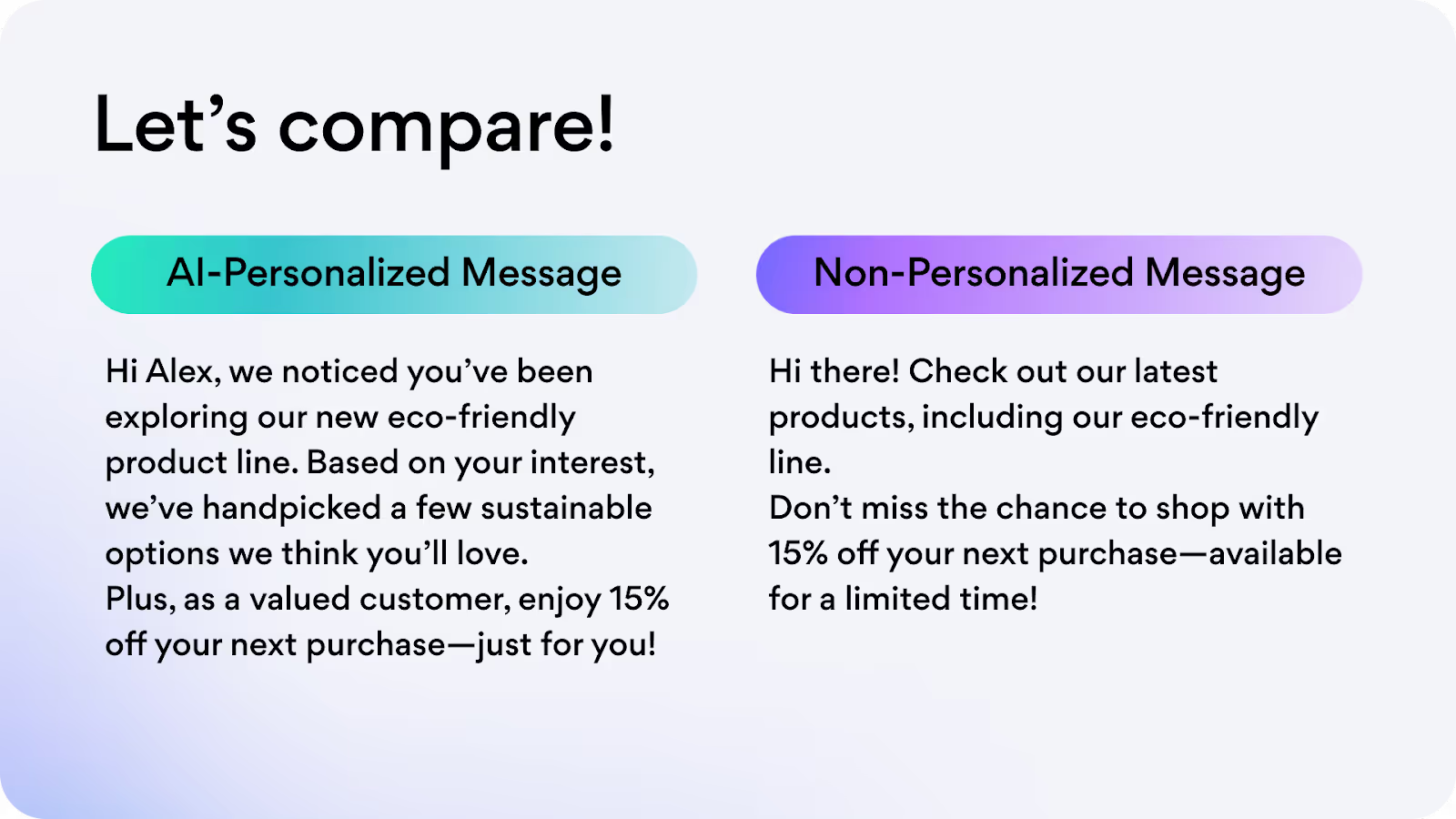
Did you feel the power of words and AI? To be more specific, let’s explore the benefits of AI-driven personalization.
Benefits of AI Personalization in Tailoring Experiences
Hyper-relevant content delivery
AI analyzes user behavior, preferences, and past interactions to provide content that matches individual needs.
For example, a user visits your platform for the second time and is greeted with their most-used features, preferred color themes, or unfinished projects.
Dynamic and adaptive interfaces
Personalized AI can adapt interfaces in real time based on user data, layouts, navigation paths, and feature visibility.
For example, an e-commerce app shows casual clothing for a customer who recently browsed sneakers, while another user sees trending formalwear.
Emotional connection
AI creates a sense of being understood and valued. These personal touches foster an emotional connection. As a result, users become loyal advocates.
For example, a fitness app sends a motivational message after analyzing a user's workout streak, and a streaming service creates a playlist aligned with their unique taste in music.
Consistent brand experience across channels
AI ensures that the tailored experience extends seamlessly across all touchpoints.
For example, a customer browsing a product on your website sees the same personalized recommendations when they open your app.
The benefits are exciting, but let's see how they transform into numbers!
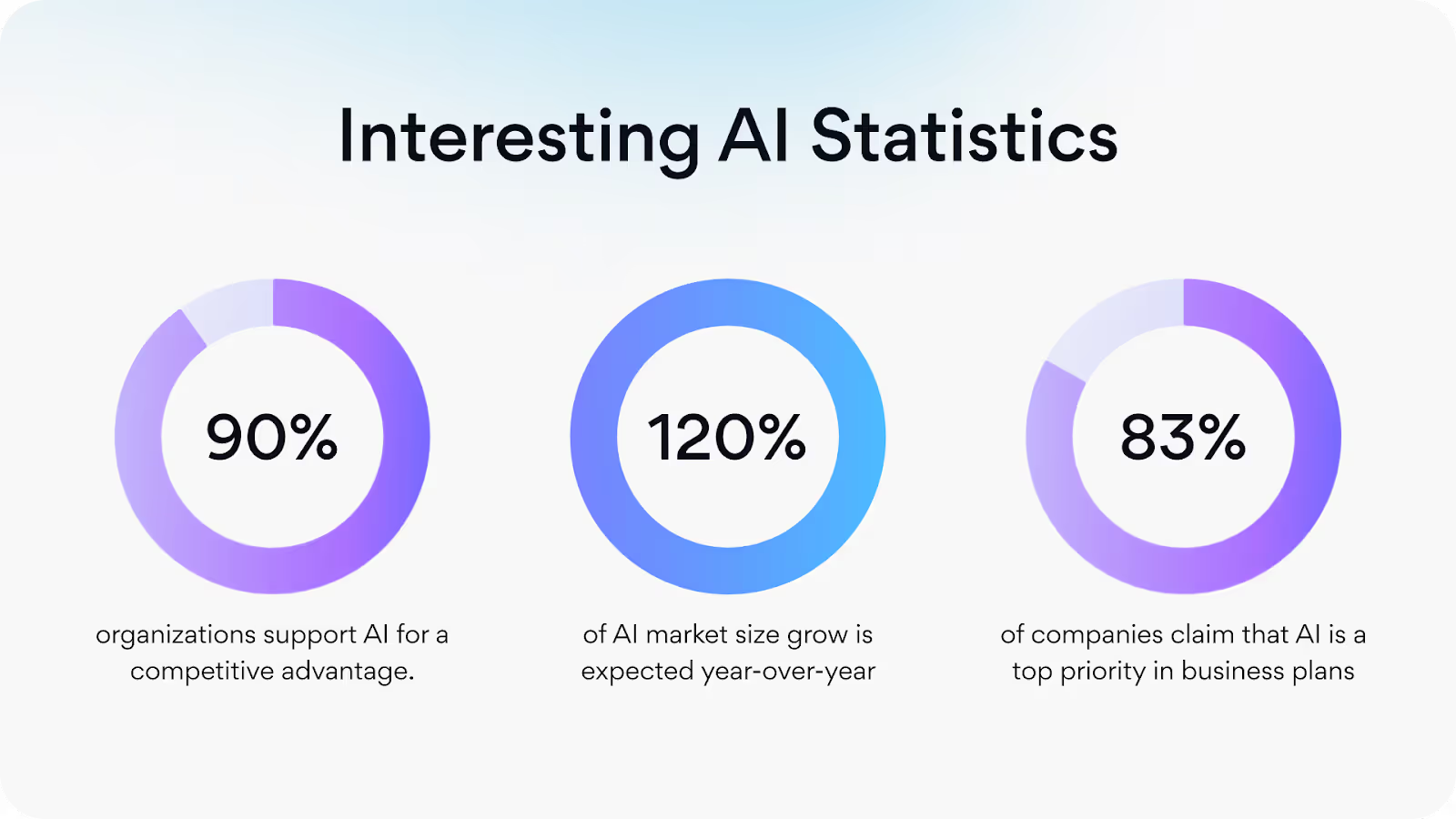
How AI Personalization Enhances Customer Experience
AI based personalization makes things convenient and pleasant for people and at the same time improves your business metrics, increases revenue, and allows you to attract new audiences. How can AI do this? Let’s dive into some details of its processes.
Customer Data and Insights
The personalization process mainly focuses on gathering and analyzing customer data at scale. AI sifts through vast datasets to uncover meaningful patterns (behaviors, preferences, and trends).
How does it work?
- AI tracks user interactions, such as clicks, searches, and purchases, to understand what matters most to them.
- Instead of broad customer groups, AI creates hyper-targeted segments that reflect real, individual needs.
- Using historical data, AI forecasts what customers might want next, helping businesses stay one step ahead.
Why does it matter for your business?
You don’t need to create assumptions about what users want or how they will act. Now, you can use AI for content personalization and make data-driven decisions to drive stronger engagement and loyalty.
Real-Time Adaptation and Predictive Capabilities
Compared with traditional systems that rely on static rules, AI evolves dynamically, adjusting to user behavior at the moment. It helps you grow, right?
How does it work?
- Websites and apps adapt their layouts, content, or recommendations as users navigate.
- AI anticipates user needs before they are expressed. It suggests the next step in a process or offers timely discounts.
- AI ensures consistency across platforms (yeah, we talk about consistency so often because it’s really important!), so users feel recognized whether they’re on a mobile app, desktop, or in-store.
Why does it matter for your business?
Real-time adaptation makes every interaction feel fresh and intuitive. It reduces friction and increases satisfaction. Customers feel like the experience evolves with them, not against them.
Interested in real-world examples? Well, recently, our Arounda designers created an AI-based project, MOJO-CX. The platform is a SaaS B2B solution that assists contact center leaders in reducing costs, increasing revenue, and enhancing quality through AI-powered real-time coaching and conversational prompts. Find out all nuances in our case.
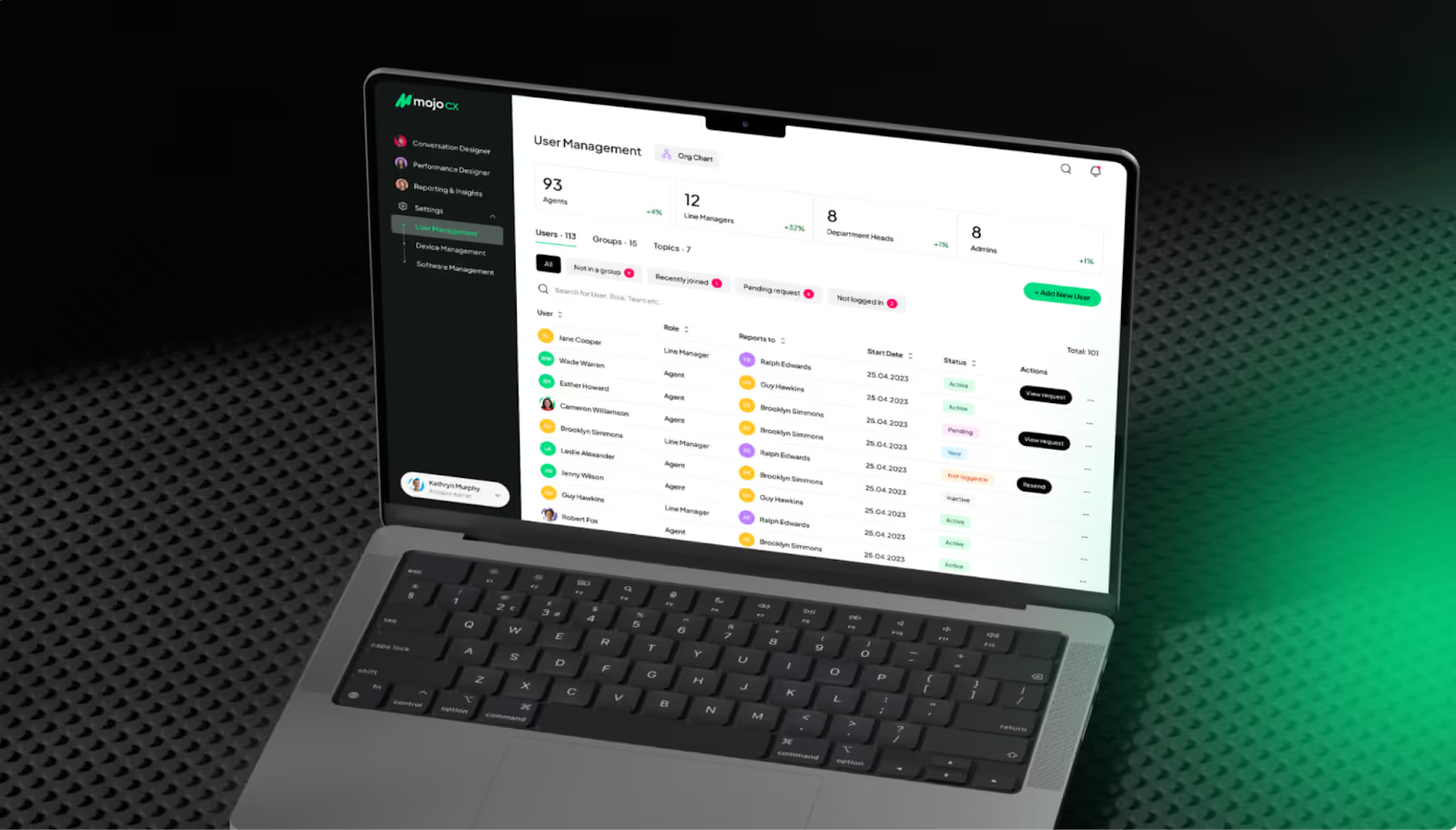
We discussed the benefits of tailoring experience, and now we show how your business can benefit from AI.
Key Benefits of AI Personalization for Businesses
Your strategic advantage is to deliver highly tailored customer experiences. Remember, it’s not a trend anymore! Here’s how it delivers real business impact.
Enhanced Customer Engagement and Satisfaction
Customer interactions become more relevant, efficient, and meaningful with AI. Real-time data and advanced analytics help businesses create experiences that resonate deeply with their audience.
How does AI deliver these results?
- Dynamic content adapts to individual preferences (this increases relevance and time spent on platforms).
- Tailored product or service recommendations streamline decision-making (this reduces friction in the user journey).
- AI-powered chat solutions provide instant, context-aware support (this resolves issues faster and improves satisfaction).
What is the business impact?
Engaged and satisfied customers convert, return, and promote your brand. Companies using AI often see improved Net Promoter Scores (NPS) and higher customer satisfaction ratings.
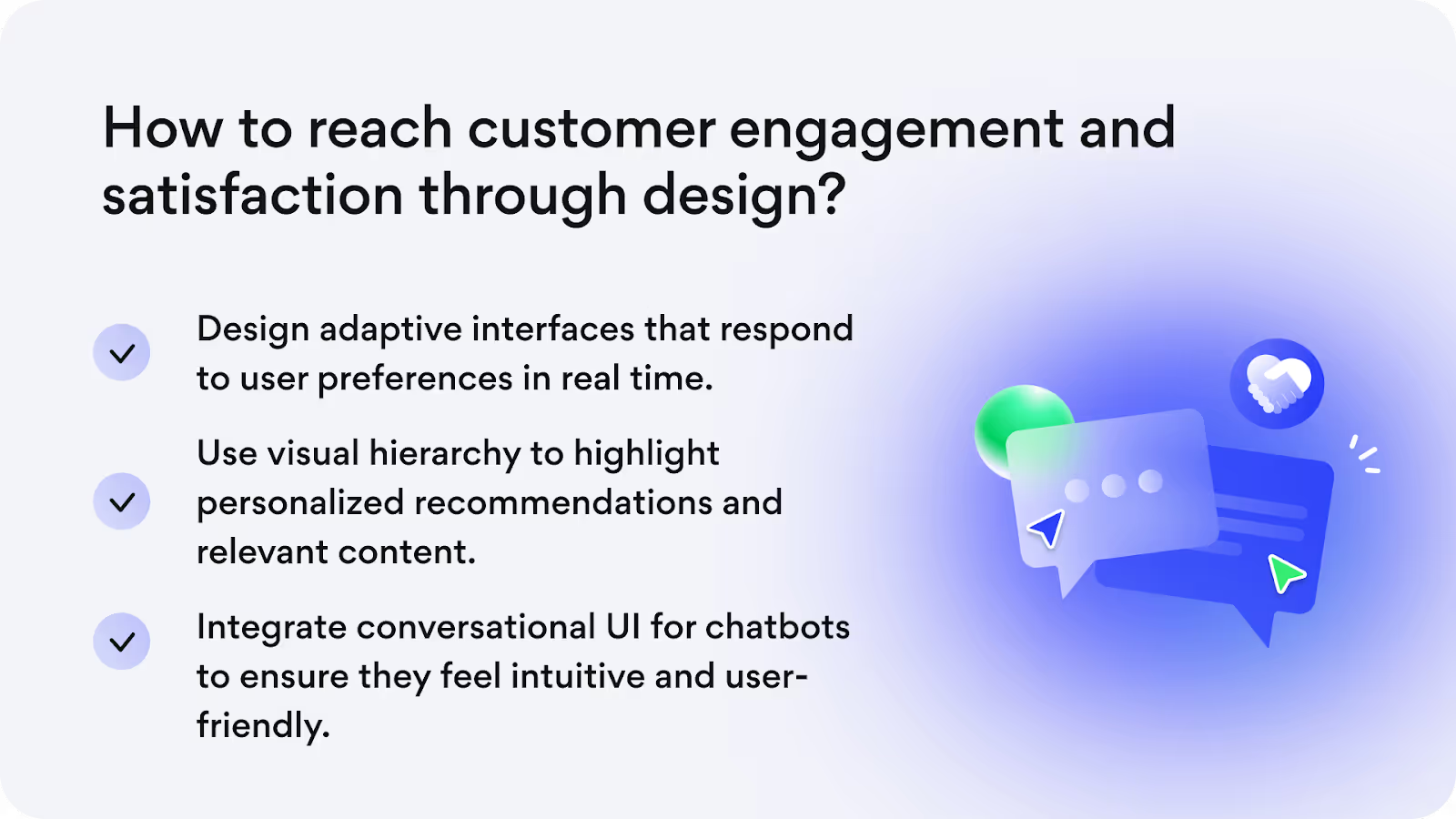
Increased Conversion Rates and Revenue
From personalized marketing messages to sales forecasting tactics, artificial intelligence helps companies capitalize on high-value opportunities.
How does AI deliver these results?
- Predictive algorithms identify customer intent (this ensures timely delivery of offers or content).
- Personalized pricing strategies and dynamic bundling align with customer behavior (this maximizes value perception).
- Intelligent upselling and cross-selling recommendations increase average order value (AOV).
What is the business impact?
Personalization leads to measurable improvements in conversion rates. Businesses report revenue growth as high as 20-30% due to targeted, data-driven campaigns.
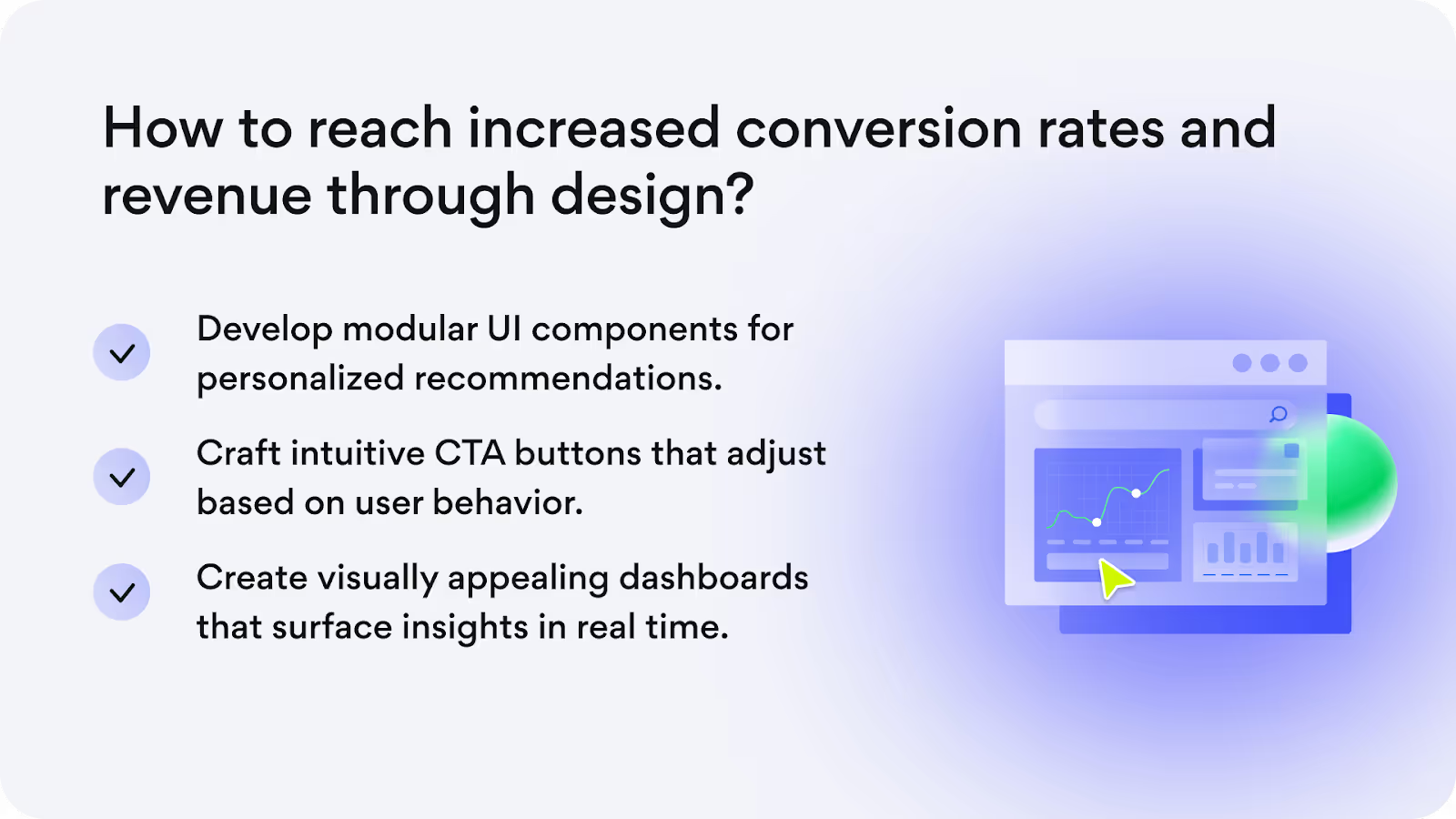
Improved Customer Retention and Loyalty
When users feel that a brand understands them and creates a deep connection, like with a friend, then loyalty follows. They want to stay longer and explore. Right? Personalized experiences keep users coming back, increase time spent on your platform, and reduce churn.
How does AI deliver these results?
- AI tracks user behavior over time to adapt offerings and match evolving preferences.
- Personalized loyalty programs encourage repeat engagement and deepen customer loyalty.
- Proactive re-engagement strategies (reminders or exclusive offers) maintain long-term connections.
What is the business impact?
Retained customers contribute to profitability as they’re 5-7 times less expensive to serve than acquiring new ones.

We at Arounda combine AI personalization with user-centered design to create tailored business experiences. We help our clients achieve goals through intelligent design. Explore our works, which have gained numerous awards.

The benefits and examples are significant, but now it’s time to talk about realization. Creating tailored customer experiences requires the right tools. Let’s discover!
Practical Applications of AI Personalization in CX
Personalization with AI improves customer experience(CX) by delivering relevant, seamless, and engaging interactions. Here, we have gathered the most practical applications and show how AI enhances CX across industries.
Personalized Product Recommendations
What AI does:
- Recommends complementary or related products to boost cross-sell opportunities.
- Highlights trending or new arrivals based on a customer’s interests.
- Adapts recommendations in real-time as customers interact with products.
For example, E-commerce platforms like Amazon and Shopify use AI to display “customers also bought” or “recommended for you” sections tailored to individual users.
How can you reach it with design?
- Integrate recommendation carousels with clean, visually engaging layouts.
- Use interactive elements, like “hover to preview”.
- Make sure recommendations blend seamlessly into the UI for a cohesive experience.
AI-Powered Chatbots and Virtual Assistants
What AI does:
- Provides instant responses based on user intent and historical interactions.
- Offers real-time and multilingual support.
- Learns and improves over time to deliver accurate assistance.
For example, Sephora uses AI chatbots to recommend products, and Google Assistant provides tailored daily updates and reminders.
How can you reach it with design?
- Design conversational interfaces that feel human and approachable.
- Include quick-reply buttons and visual cues to simplify interactions.
- Optimize for mobile to ensure seamless experiences across devices.
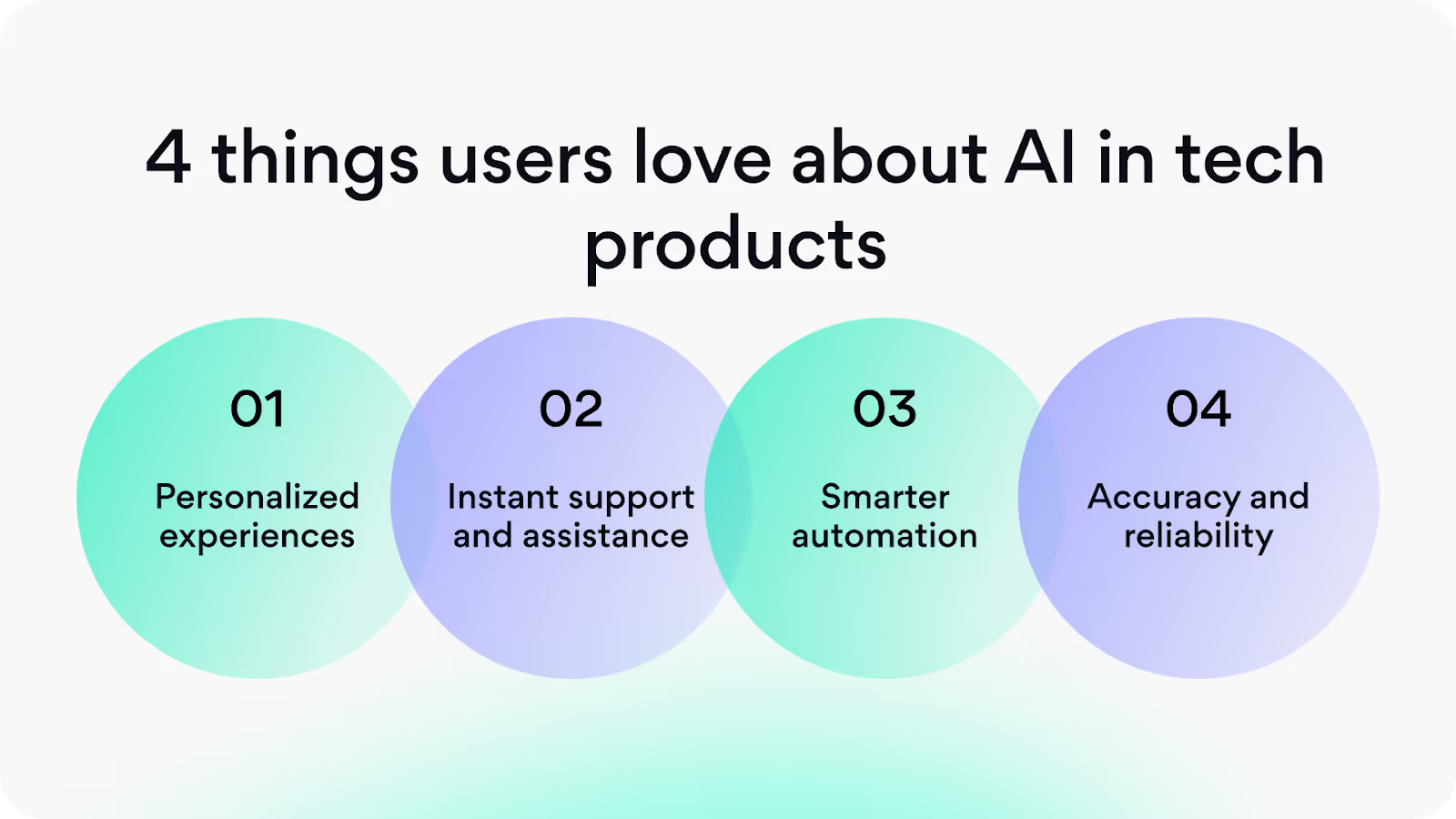
Dynamic Website Personalization
What AI does:
- Prioritizes content and products based on user demographics and behavior.
- Adjusts the homepage dynamically (shows different features or offers to different user segments).
- Personalizes calls to action for higher engagement and conversion rates.
For example, Netflix and Spotify highlight recommendations and continue where users left off.
How can you reach it with design?
- Implement modular layouts that adapt seamlessly to user data.
- Use subtle animations to highlight personalized elements.
- Ensure responsive design for consistency across devices and screen sizes.
We have another AI project to show you to help you better understand how AI integration works. We designed an HR platform, Sinta. It allows HR teams to hire faster and smarter by streamlining the interview process with customizable templates, AI-powered tools, and recorded video transcripts. Check our case to find out all the details.
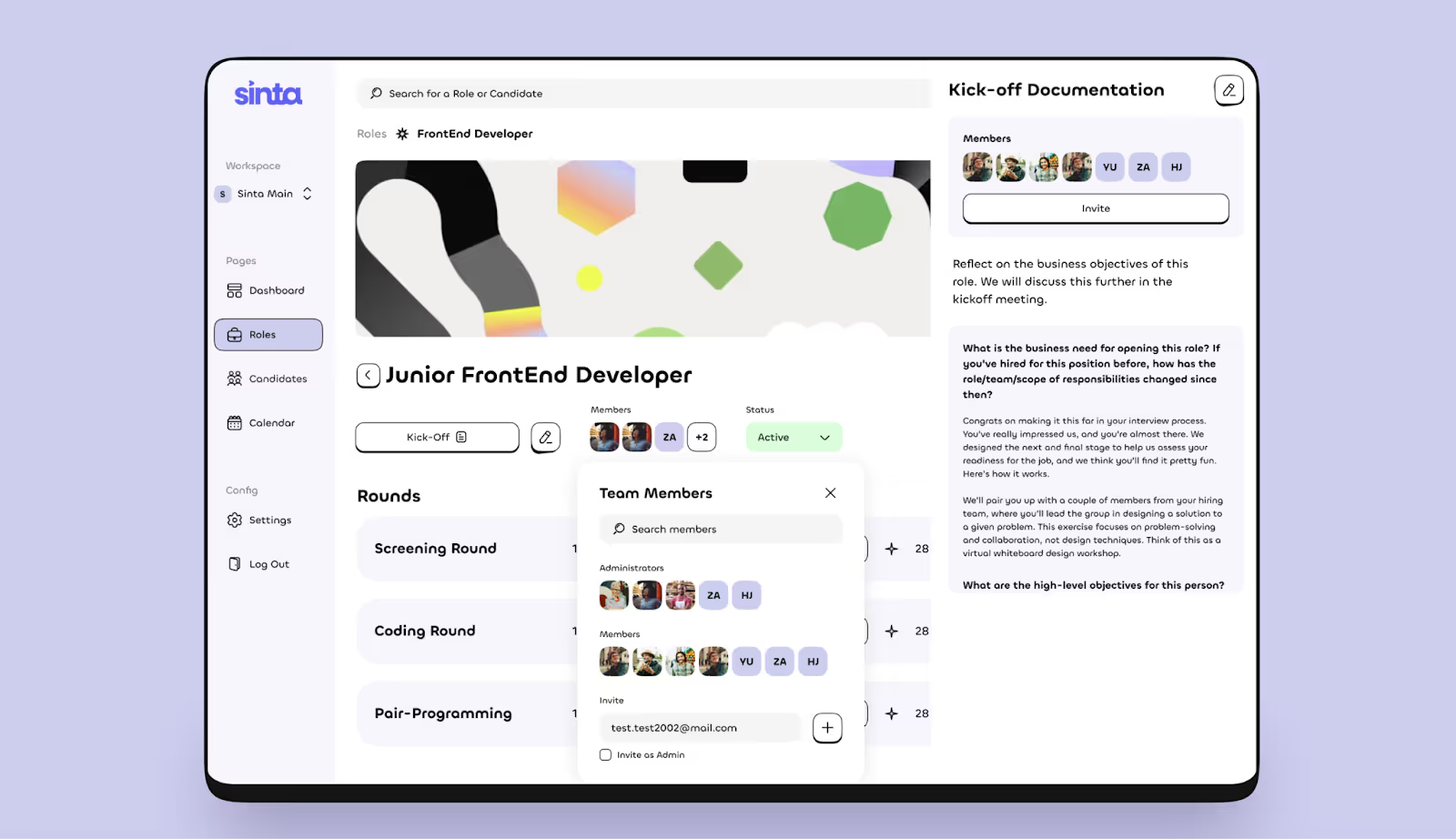
Targeted Ad Campaigns
What AI does:
- Creates dynamic ad content based on user interests and past interactions.
- Uses predictive analytics to time campaigns.
- Optimizes ad placements and formats to match user preferences.
- Create a new direction - AI personalization marketing.
For example, Facebook and Google Ads use AI to target audiences with ads based on their search and browsing history to increase click-through and conversion rates.
How can you reach it with design?
- Design visually cohesive ads that align with your brand’s identity.
- Use attention-grabbing yet relevant visuals and concise messaging.
- Test and iterate ad designs based on user engagement metrics.
At Arounda, we specialize in designing AI-powered digital experiences to deliver tailored solutions for your customers. We want your AI implementation not just to function; it must shine! Explore our design services to see how we can transform your AI vision into a reality.
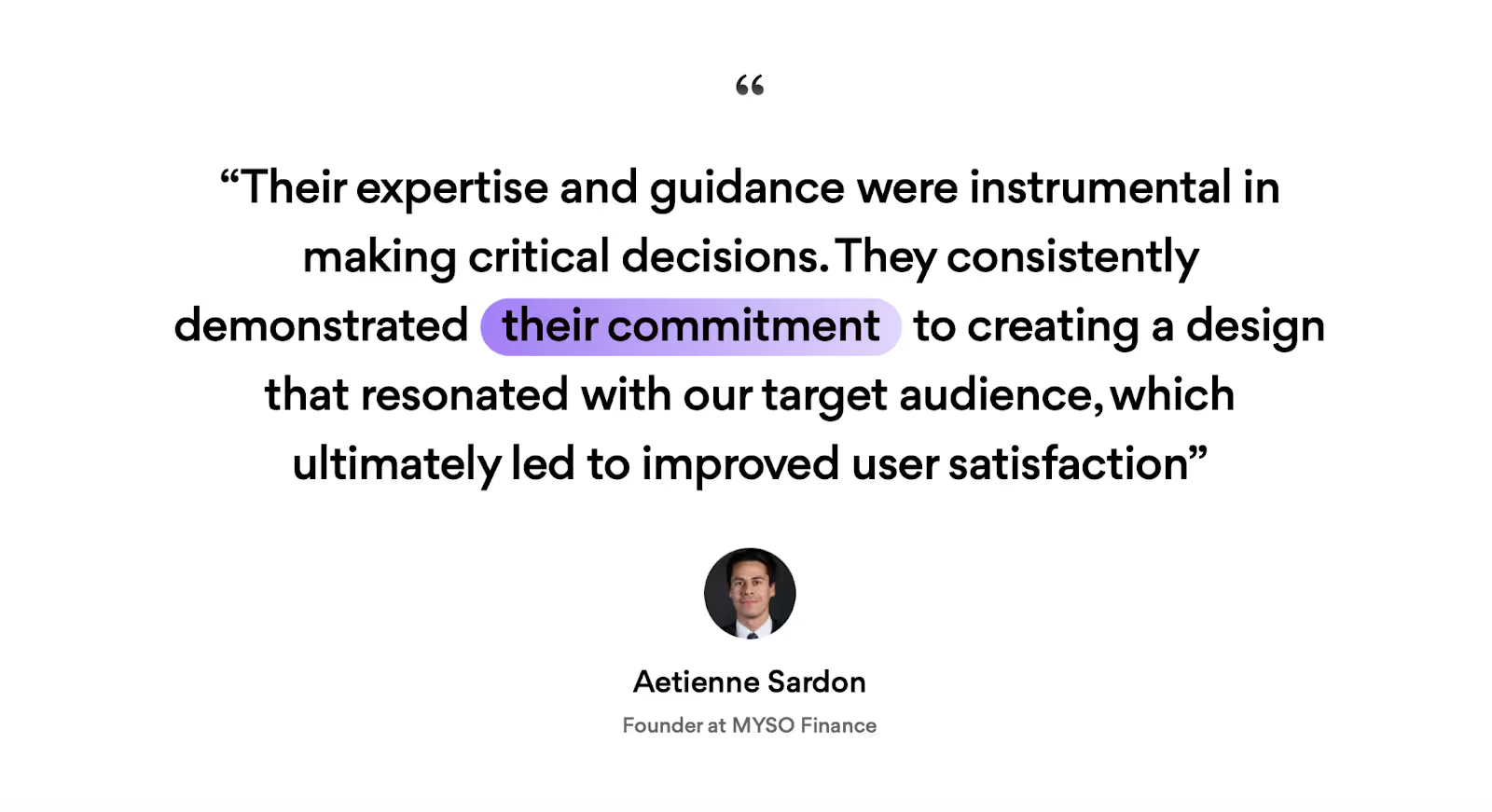
You should implement AI strategically to achieve exceptional results; that’s why our experts tell you the best practices to follow.
Best Practices for Successful AI Personalization
Personalization with AI isn’t just about deploying technology! As we said, it’s about strategic usage for meaningful and scalable CX. Here are the best practices to ensure your efforts yield the best results.
Selecting the Right AI Tools and Platforms
The platform and tools you select should align with your business goals, integrate seamlessly with your existing systems, and offer the flexibility to scale as your needs grow.
What you should consider?
- Industry-specific features.
- Integration capabilities (with your CRM, CMS, or other data systems).
- User-friendliness.
Ensuring Data Accuracy and Quality
Poor quality or incomplete data can lead to irrelevant experiences, undermine customer trust, and reduce the value of your personalization efforts.
What you should consider?
- Regularly review and clean datasets to remove inaccuracies and outdated information.
- Consolidate data from various touchpoints for a holistic view of your customer.
- Implement robust measures to ensure data compliance and protect customer information.
Continuously Monitoring and Optimizing Personalization Efforts
Personalization isn’t a set-it-and-forget-it solution. Personalization strategies must evolve alongside customer behaviors and market trends. If not, then you should improve it. That’s why continuous monitoring is so important!
What you should implement?
- A/B testing.
- Performance analytics.
- Iterative improvements.
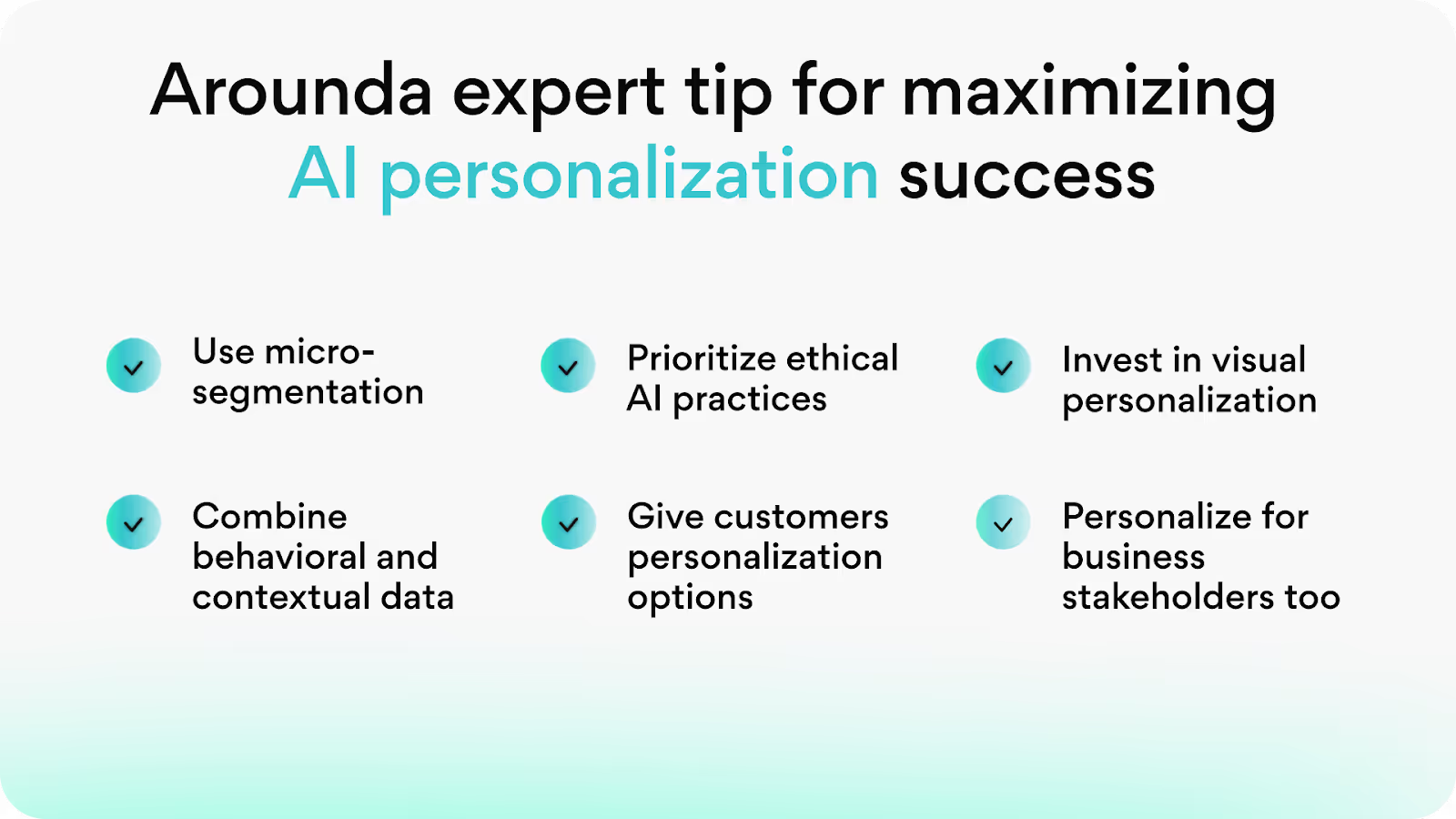
Final Thoughts
Customers demand relevance and connection, right? And these are what AI offers: uniquely tailored, intuitive, and impactful user experience!
Imagine a platform where every interaction feels seamless, every recommendation feels spot-on, and every customer feels valued. That’s the transformative power of AI. And you can easily reach it. Just combine cutting-edge AI technology with expert design and enjoy new success!
Your customers are ready for something extraordinary. What about you? Contact us today to start your journey toward next-level personalization!














